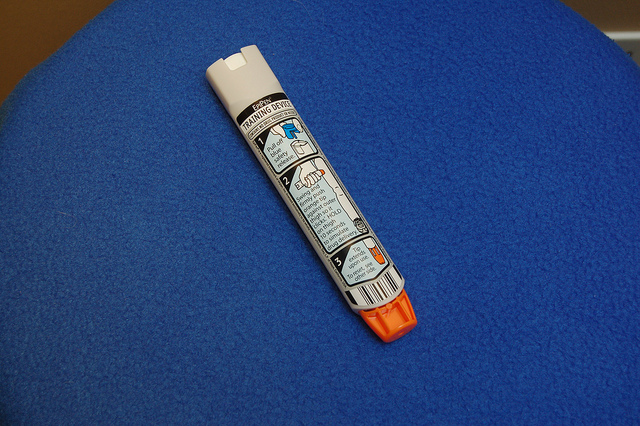 A few days ago ProPublica had a headline I wished I'd written: If It Needs A Sign, It's Probably Bad Design. Although the article started with a health care example (EpiPen of course, citing Joyce Lee's brilliant post), it wasn't focused on health care -- but it might as well have been. Health care is full of bad design, and of signs. Take, for example, the waiting room. When most patients enter a provider's office or facility, the first thing they are likely to see is a waiting room. The waiting room probably has other would-be patients already waiting there, each full of their own health concerns. In some instances, the initial waiting room is merely a staging area; once processed, patients may be sent to yet another waiting room to wait some more. And, of course, once they eventually do reach an exam room, they'll probably endure some more waiting, no matter how long their wait has already been...
A few days ago ProPublica had a headline I wished I'd written: If It Needs A Sign, It's Probably Bad Design. Although the article started with a health care example (EpiPen of course, citing Joyce Lee's brilliant post), it wasn't focused on health care -- but it might as well have been. Health care is full of bad design, and of signs. Take, for example, the waiting room. When most patients enter a provider's office or facility, the first thing they are likely to see is a waiting room. The waiting room probably has other would-be patients already waiting there, each full of their own health concerns. In some instances, the initial waiting room is merely a staging area; once processed, patients may be sent to yet another waiting room to wait some more. And, of course, once they eventually do reach an exam room, they'll probably endure some more waiting, no matter how long their wait has already been...
EpiPen
See the following -
EpiPen Delivers Epinephrine and Healthcare Insight: Price Gouging and Medical Extortion
 The header image is a chart that was part of an article by Bloomberg — written over two years ago (May, 2014). The data itself goes back 9 years. Mylan's price gouging was front and center this week, but the issue has been actively percolating for years. It has also erupted before and it will again. Everyone's squawking and legislators are "looking into it," but it won't be solved this year — or even this election cycle. Here's why...
The header image is a chart that was part of an article by Bloomberg — written over two years ago (May, 2014). The data itself goes back 9 years. Mylan's price gouging was front and center this week, but the issue has been actively percolating for years. It has also erupted before and it will again. Everyone's squawking and legislators are "looking into it," but it won't be solved this year — or even this election cycle. Here's why...
- Login to post comments
Epipen: A Sign of a Broken Healthcare System
 It has been going on for years. The difference is that now the media is hopping on the story. Now America is paying attention. In 2015, the price of doxycycline, a generic antibiotic, was up to $5 per pill, an increase from $0.03 in 2014. The antibiotic is the gold standard treatment for Lyme disease. In 2015, the price of Daraprim (pyrimethamine), was up to $750 per pill, an increase from $13.50. The antiparasitic medication is used to toxoplasmosis, an infection acquired in people who have HIV/AIDS...
It has been going on for years. The difference is that now the media is hopping on the story. Now America is paying attention. In 2015, the price of doxycycline, a generic antibiotic, was up to $5 per pill, an increase from $0.03 in 2014. The antibiotic is the gold standard treatment for Lyme disease. In 2015, the price of Daraprim (pyrimethamine), was up to $750 per pill, an increase from $13.50. The antiparasitic medication is used to toxoplasmosis, an infection acquired in people who have HIV/AIDS...
- Login to post comments
Exorbitant Prices Are Just One Reason to Loathe the Company That Makes the EpiPen
It’s not hard for pharma companies to appear villainous, but Mylan, the maker of the EpiPen, may be in a class by itself. Mylan has drawn the ire of patients, consumer groups and now Congress for raising the price of the device 400% since it acquired EpiPen in 2007. The implement, which delivers life-saving medicine for severe allergy sufferers, can now cost more than $300 per pen. It’s only sold in pairs and must be purchased every year because the drug, epinephrine, loses potency over time. Sales of EpiPen are now in excess of $1 billion annually...
- Login to post comments
Hackers Created a $30 DIY Version of the EpiPen
The EpiPen is a potentially life-saving device for those with severe allergies or asthma. The problem is that it costs $600 in the US. For those with or without respiration woes, the EpiPen represents what’s wrong with drug manufacturing nationally, namely high prices and manufacturer monopolies. Mylan, maker of the EpiPen, raised the device’s price 300% in seven years from 2009 to 2016, mostly because it could...
- Login to post comments
Mylan Isn't Alone: 11 Drugmakers with Off-the-Charts Pricing Power
Mylan (MYL) is drawing fire for passing off massive price hikes for its EpiPen allergy treatment. But it’s far from being the drug company with the most pricing power. Gilead (GILD), Biogen (BIIB) and Amgen (AMGN), along with eight other drug giants in the Standard & Poor's 500, enjoyed off-the-charts pricing power on their products relative to costs — far beyond Mylan's, according to a USA TODAY analysis of data from S&P Global Market Intelligence...
- Login to post comments
Solving Design Problems in Healthcare Starting with the Waiting Room
- Login to post comments